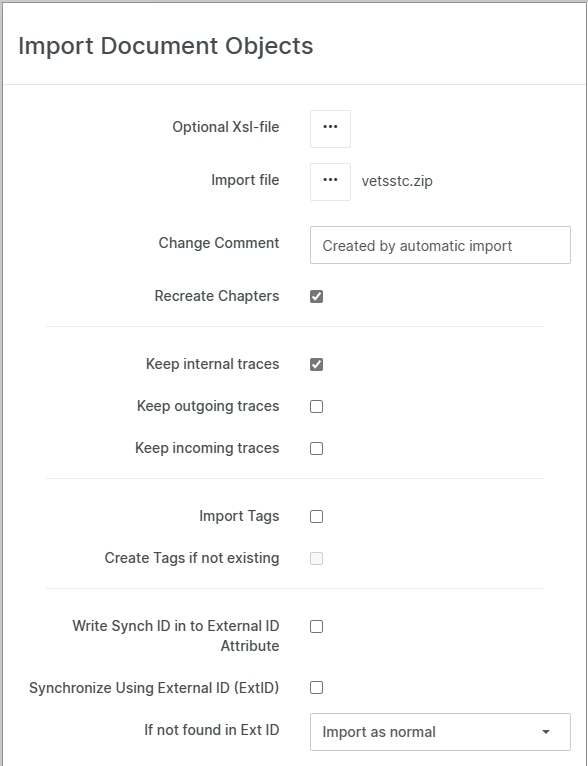Import Document Objects
It is possible to import Document Object from files exported using the default XML Transformation or manually/externally created. Importing Document Objects is only possible from the Chapter View.
How to import Document Objects
Prepare the import action by zipping the files you intend to import. This must include the main XML file, all additional Rich Text help files, and their respective directories.
To import Document Objects:
Select the target Chapter in the Chapter View by navigating to the Chapter and select Go to Chapter to make the selected Chapter root Chapter in the Chapter View
Click the Ellipsis button next to the Root Chapter in the Chapter View
Select Import Document Objects in the dropdown. This will display the Import Document Objects dialogue.
Once the options are set, click OK to start the import.
The following rules apply to importing:
Document Objects of the same type as the target chapter will be placed in the target chapter.
Document Objects of different types are placed in the applicable book (under the root chapter).
The Document Objects will receive new IDs as they are imported.
If a Document Object is imported several times, a copy with a new ID of the object is created each time.
Options in the Import Document Objects dialog

Import XML or Zip File
Browse to the XML file you have prepared. If you want to import many XML files in one go, zip them and select the zip file.
After assigning the file to import, the dialogue displays a list of all Document Objects found inside at the bottom. You can use the checkboxes in the list to include or exclude items on the list.
Mapping unknown Document Object types and attribute
If the import function does not recognize the Document Object types, attributes and attribute values in the import file(s) due to a mismatch between the current configuration and the content of the import file(s), you will be prompted with an option to map this unknown types, attributes and attribute values to known types, attributes and attribute values.
Optional XSL File
If the imported file is not of the native Aligned Elements XML format, an optional XSL transformation file can be added to transform the imported file to the proper format.
Change Comment
You can here customize the initial change comment (set for revision 1) used when the objects are created; e.g., “Imported from internal system so-and-so”.
Recreate Chapter
By default, exported Document Objects also contain their original chapter path. With this option selected, the chapter path is recreated (if it does not already exist) and the imported object is automatically placed in that chapter.
Keep internal, outgoing, and incoming traces
Trace information is also, by default, included in the export object description and traces can be recreated if the options are selected.
Keep Internal Traces signifies traces that exist between the imported objects. When this option is selected, the traces between the imported objects are recreated.
Keep Outgoing Traces signifies traces from the imported objects to other objects in the source project. When this option is selected, traces from the imported objects are created to these other objects in the source project. Therefore, this feature only applies when working with Linked Projects.
Keep Incoming Traces signifies traces from other objects in the source project to the imported objects. When this option is selected, traces from the other objects in the source project are recreated to the imported objects in the target project. Therefore, this feature only applies when working with Linked Projects.
Import Tags
If the Document Objects in the import file have been associated with Tag names (in the import file), the Import Tags option will, if enabled at import, automatically add the imported Document Objects to the specified tags in the target project, provided that these tags already exist in the target project at the time of import.
Create Tags if not Existing
As an additional option, to the Import Tags feature described above, the Create Tags if not Existing, will, if enabled at import, automatically create the tags found in the import file in the target project (provided that they do not exist) and subsequently add the imported Document Objects to these newly created tags
Write Sync ID to External ID Attribute
Synchronized import implies that the data of an existing object is overwritten with the data of an imported object.
A necessary prerequisite is that each type that is subject to synchronized import has a String Attribute with the name “ExtID”. Note that this is a strictly import relevant attribute that ought not to be included in any formal output.
By selecting the option Write Sync ID in External ID Attribute during the first import, the ID in the import file is written into the attribute value of the ExtID. If the IDs of the import file are Aligned Elements ID, the IDs written into the attribute are the full ID including project name but not revision.
Synchronize using External ID
At subsequent imports, select the option Synchronize using the External ID to overwrite objects in the project with information from the import files where the ID in the import file matches the existing ExtID value.
If not found in Ext ID
If a Document Object with a matching External ID could not be found, the user can select whether these Document Objects shall be:
Imported as new Document Objects (normal)
Skipped / Ignored / Not getting imported
